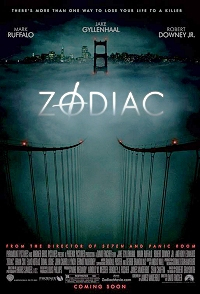 I can’t imagine a better movie about the still-unsolved “Zodiac” killings that plagued San Francisco during the late sixties and early seventies. The director of this intellectually charged but still gripping epic was David Fincher, and it’s one of his finest films.
I can’t imagine a better movie about the still-unsolved “Zodiac” killings that plagued San Francisco during the late sixties and early seventies. The director of this intellectually charged but still gripping epic was David Fincher, and it’s one of his finest films.
ZODIAC (2007) joins the short list of David Fincher masterworks, alongside SE7EN and FIGHT CLUB. The inspiration for this film was two books, ZODIAC and ZODIAC UNMASKED, both by cartoonist Robert Graysmith, who worked at the San Francisco Tribune during the Zodiac killer’s reign. Graysmith, portrayed by Jake Gyllenhaal, plays a big part in ZODIAC.
It was an expensive production (with a reported $65 million budget) with several mid-range stars (Gyllenhaal, Robert Downey Jr., Mark Ruffalo, Anthony Edwards), but wasn’t terribly successful theatrically. It did attain some popularity on DVD, a good thing for ZODIAC’S backers but a not-so-good one for viewers who missed the film in theaters, as it weaves a spell that works best on a big screen.
It all begins in July, 1969: in a secluded Vallejo, CA parking lot a young couple is senselessly gunned down by a shadowy individual. The woman dies but the man survives.
On August 1 three suspicious letters appear in the office of the San Francisco Tribune. Their author claims credit for the previous month’s shootings, as well as another double murder that occurred the previous year. Each letter includes parts of a cryptogram the writer demands be posted on the paper’s front page. The cryptogram is published in its entirety by the Tribune, and solved by an elderly housewife. By that time another letter has arrived at the Tribune offices in which the murder proclaims his identity: The Zodiac Killer.
September, 1969: another young couple is attacked, this time at the scenic Lake Berryessa. The modus operandi is a knife with which the Zodiac Killer, clad in a black outfit with an executioner’s hood, repeatedly stabs the couple. Once again the man survives and the woman dies.
October, 1969: A cab driver is shot in the head by an unseen passenger in San Francisco’s Presidio Heights. The passenger flees, passing two cops who let him go, as an eyewitness’s description of the assailant misidentified him as a black man.
The City of San Francisco is gripped by fear. A massive investigation is launched, but all it turns up are false leads. In the meantime the Zodiac Killer continues bombarding the Tribune with letters.
March, 1970: a young woman is driving down a lonely stretch of road late one night in Modesto, CA with her infant daughter in tow. Another car pulls up whose unseen male driver tells the woman that one of her rear wheels is loose. She grudgingly accepts a ride with the man, but jumps from the car with her baby when the guy threatens to throw the child out the window.
More Zodiac penned letters flow into the Tribune claiming responsibility for terrorizing the young woman, but no credible leads are found—or so it seems. Robert Graysmith, the Tribune’s political cartoonist, becomes obsessed with the case, and grows determined to solve it on his own. He receives minimal help from the various police departments but forges ahead, eventually becoming so wrapped up in the case that it wrecks his marriage.
Graysmith eventually turns his attention to a shady character named Arthur Leigh Allen, who seems the most likely culprit in the Zodiac killings, and who, unbeknownst to Graysmith, also tops the authorities’ list of suspects. But getting the charges to stick is easier said than done, and Mr. Allen dies just as the case is heating back up. Thus the identity of the Zodiac Killer remains a mystery.
This film showcases David Fincher at his surest and most confident. You’ll be hard-pressed to find a single poorly framed, mistimed, out-of-place or otherwise flawed shot. Perhaps no other modern filmmaker exacts a greater degree of perfectionism than Fincher (who’s famous for his extremely high volume of takes), and it definitely shows.
The violence may seem somewhat muted, especially in comparison with that of SE7EN and FIGHT CLUB (although the early scenes of the killer at work are strong and disturbing), but that’s part of what makes ZODIAC such an unprecedented effort. It’s concerned not with the Zodiac Killer’s crimes but with the investigation that followed. The result is very likely the most thorough and exhaustive serial killer movie of all time. We feel the yearning and frustration of its detectives and reporters as they follow one lead after another, nearly all of which lead to dead ends. The film really shouldn’t be as involving as it is—that it manages to grip viewers from start to finish despite an excessively talky 2½-hour narrative about a case that is never solved is a testament to Fincher’s genius, and the talents of his collaborators.
Of particular importance is the production design, which really immerses the viewer in late-20th Century San Francisco (the reason the film is best experienced on a big screen). The scenery is enhanced by state-of-the-art digital effects that never detract from the narrative. The photography, as in most of Fincher’s films, is dark (I mean that literally), which fits the subject matter perfectly—not unlike nearly every other element herein.
Vital Statistics
ZODIAC
Paramount Pictures/Warner Bros. Pictures
Director: David Fincher
Producers: Mike Medavoy, Arnold W. Messer, Bradley J. Fischer, James Vanderbilt, Cean Chaffin
Screenplay: James Vanderbilt
(Based on a book by Robert Graysmith)
Cinematography: Harris Savides
Editing: Angus Wall
Cast: Jake Gyllenhaal, Mark Ruffalo, Robert Downey Jr., Anthony Edwards, Brian Cox, Elias Koteas, Donal Logue, John Carroll Lynch, Dermot Mulroney, Chloe Sevigny, Ione Skye
